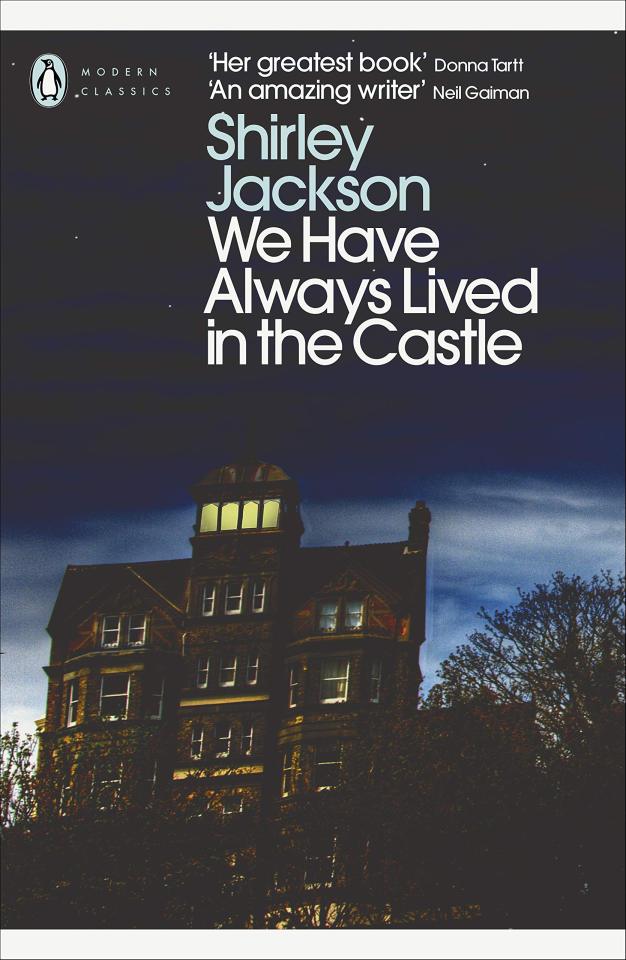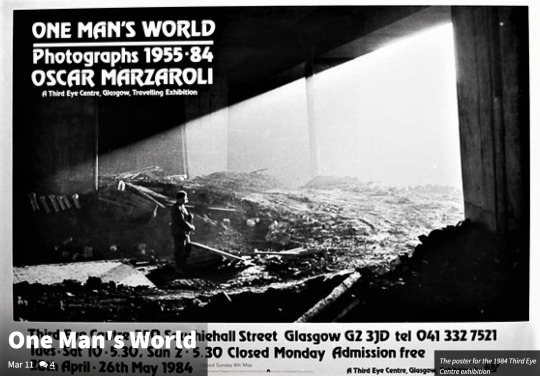#the first on the third row was the original 1962 edition
Explore tagged Tumblr posts
Photo








We Have Always Lived in the Castle by Shirley Jackson: English covers
#we have always lived in the castle#shirley jackson#book covers#book#literature#I own the first one and I love it#almost gives you a claustrophobic feeling#but most of these slap so hard#I'm obsessed with the second one and Merricat wearing the table cloth#and the design of the Blackwood gate#the first on the third row was the original 1962 edition
8K notes
·
View notes
Text
Exhibition - Oscar Marzaroli
Visited 18.09.2020
How does the flyer/poster advertise the exhibition?,
“Street Level Photoworks - 30 Years of Photography in Scotland”
The flyer for this exhibition briefly charts Marzaroli’s life from his birth in Italy in 1933 until his early death in 1988. It outlines his brief career and its significance in capturing the essence of Glasgow, its industry, its people and its social context. It talks of his body of work and the role of the Gallery in pulling the exhibition together.
The brief bio of the photographer’s work encompasses many of his achievements and signposts the reader to other sources of his work including books, record covers, documentaries and college archives including the huge collection gifted by his family* to Glasgow Caledonia University *The Marzaroli Collection.
In addition to the flyer the gallery also provides a leaflet which opens up to an A2 double sided sheet with extracts from the gallery’s display and further information on the artist.
*https://vimeo.com/392431586
What is the suitability of the gallery space?
Street Level Photoworks is a Glasgow photography gallery, and as such is a perfect venue for Marzaroli’s homage to his adopted city.
The gallery space is ideal, not only is it situated in one of the main streets in Glasgow with direct access from 2 ground floor entrances, but its large windows give passers-by a glimpse of the exhibition which entices them in. The two rooms which house the exhibition are well lit and the walls provide sufficient space for images to be divided into groups (people, places, industry, Gorbals, portraits) allowing the viewer to explore and move from one context to another without breaking the narrative of the work.
How is the exhibition laid out?
The gallery has used a variety of methods to display the work, all of which have been printed in black and white and mounted on white card before being placed in a simple black frame. The backdrops for the frames are varied, some hang neatly in parallel rows against a plain white or green wall, others are clustered together, and several others are placed in front of huge prints of football crowds or music concerts which have been pasted, billboard style, directly onto the walls. Large posters of contact sheets are interspersed amongst the prints complete with annotations and there are also central displays with artefacts from his work including records of shoots, contact sheets, negatives and equipment.
The whole exhibition has an eclectic feel to it which seems to me to mirror Marzaroli’s style of photography where he collected images and scenes as they arose whilst exploring Glasgow.
How has the work been mounted? Is this appropriate for the work?
The work is mounted and framed using a simple white mount and black frame and is very appropriate for this type of work which is unembellished and captures life as it was in the 1960s, 70s and 80s Glasgow.
Who made the work?
Although the work was originally created by Oscar Marzaroli, he died in 1988 and left behind a huge archive of over 50,000 negatives. These were often unfinished images, and many were scanned, edited and printed specifically for the exhibition.
Who did they make it for, who is the audience?
The viewer gets the impression that the images were made in the first instance for Marzaroli, shooting things that interested him as he moved around Glasgow from this, themes seem to have arisen, and as such he has developed his focus on them. Later as interest grew in his work, he put together a collection to accompany the Poetry anthology “Noise and Smokey Breath” and had a solo exhibition at the (…very hip, gosh I miss that place!) Third Eye Centre in both 1984 and 1987.
Posters from his exhibitions in the Third Eye Centre


Since his early death in 1988 his work has been in the care of his family and more recently (2019) donated to Glasgow Caledonian University. His family are very keen to have his work shared with a wider audience and have worked cooperatively with all concerned to see this realised.
How does it make you feel?
For me the work evokes feelings of nostalgia, growing up in the 60’s and 70’s many of the scenes are familiar to me and very relatable. I have walked through these streets, participated in these playground games, worn these fashions, and seeing them captured I remember how much fun I had as a child and teenager. It also makes me want to share the experience of the exhibition, to visit again with my childhood friends and in particular with my brother who still works in shipyards and would fit into many of the industry scenes to this day.

John Smith Bookshop , St Vincent street 1962
memory - my dad used to take us here every month to spend our pocket money.

Gorbals 1963
Memory, my cousins and me were always coming home with our clothes ripped from climbing up on the walls behind my Gran’s tenement in Anderson.
If the work has a title does it make you think about the image/s differently?
The title is simply “Oscar Marzaroli” which implies the photographer needs no further introduction, this is true as even those who don’t know who he is will be familiar with at least one of his iconic portrayals of Glasgow.
How would I describe it to someone later?
As an uplifting experience and an opportunity not to be missed. The photographs cover such a wide range of topics that it is unlikely that a visitor will not find an image they can relate to.
Does the photograph make you want to ask questions, what are these questions?
Yes, it makes me want to ask the photographer how he managed to discover so much about the City and its people? I imagine him walking around for hours slowly getting to know every nook and cranny. The record of the conversation between Oscar Marzaroli and Jennie Renton in the book of the Exhibition (Oscar Marzaroli, 2020) sheds considerable insight on his motivation and his own influences.
Is the photograph valuable? How do you know? Is the work for sale and who might buy it?
According to the curator, prints are sold from a variety of sources. The prints vary in value from a few hundred to thousands, and some are available in the gallery shop at reasonably accessible prices, some rarer prints, signed copies and limited editions command much higher prices and can be purchased from the trust or websites such as McTears Auctioneers.
What information is available about the artist/s?
There is a lot of information available about the artist including books, videos, and websites. A simple google search brings up pages of information and the gallery has provided information both in print and digitally.
Who organised the exhibition and who selected the work?
The exhibition was organised by Street Level Photoworks in collaboration with, Glasgow Caledonian University and the family of Oscar Marzaroli.
0 notes
Photo

Competitions resumed with the 1950 World Cup in Brazil, which was the first to include British participants. British teams withdrew from FIFA in 1920, partly out of unwillingness to play against the countries they had been at war with, and partly as a protest against a foreign influence to football,[13] but rejoined in 1946 following FIFA’s invitation. England’s involvement, however, was not to be a success. The English failed to make the final group round in a campaign that included a surprise 1–0 loss to the United States.[14] The tournament also saw the return of 1930 champions Uruguay, who had boycotted the previous two World Cups. For political reasons, Eastern European countries (such as Hungary, the Soviet Union and Czechoslovakia) did not enter. Title-holder Italy did take part, despite the Superga air disaster of 1949 in which the entire Grande Torino team (many who were national team players) were killed. The 1950 World Cup was the only tournament not to stage a final tie, replacing knockout rounds with two group phases. The last match of the second group phase, however, is sometimes referred to as a “final”, as the group standings meant the winners would be the overall winners. Uruguay were surprise victors over hosts Brazil with a final score of 2–1 (the game would later be known as Maracanazo), and became champions for the second time. This game also held the record for the highest attendance at any sporting match, at roughly 200,000.[15] Clock installed in the Wankdorf Stadium in Bern in the final match of the 1954 FIFA World Cup The 1954 World Cup, held in Switzerland, was the first to be televised. The Soviet Union did not participate because of their dismal performance at the 1952 Summer Olympics. Scotland made their first appearance in the tournament, but were unable to register a win, going out after the group stage. This tournament set a number of all-time goal-scoring records, including highest average goals per game and highest-scoring team (Hungary), and most goals in a single match (Austria’s 7–5 quarter-final victory over Switzerland). West Germany were the tournament winners, defeating Olympic champions Hungary 3–2 in the final, overturning a 2–0 deficit in the process, with Helmut Rahn scoring the winner. The match is known as the Miracle of Bern in Germany. Brazil won the 1958 World Cup, held in Sweden, and became the first team to win a World Cup outside their home continent (only 4 teams have done this to date – Brazil in 1958, 1970, 1994 and 2002, Argentina in 1986, Spain in 2010 and Germany in 2014). The Soviet Union participated this time, most likely due to their win at Melbourne 1956. For the first (and so far only) time, all four British teams qualified for the final round. Wales was able to take advantage of a situation in the Africa/Asia zone, where the number of withdrawals would give Israel qualification without having played a single qualifying match. This prompted FIFA to rule that qualification without playing was not allowed (despite allowing this to happen in earlier years of the Cup), and so Israel were ordered to play against one of the teams finishing second in the other groups. A tie was created, and Wales defeated Israel 2–0 twice in 1958. It was the first (and so far the only) time that a country played a World Cup final round after having been eliminated in the regular qualifiers. The tournament also saw the emergence of Pelé, who scored two goals in the final. French striker Just Fontaine became the top scorer of the tournament. The 1960s Edit Chile hosted the 1962 World Cup. Two years before the tournament, an earthquake struck, the largest ever recorded at 9.5 magnitude, prompting officials to rebuild due to major damage to infrastructure. When the competition began, two of the best players were in poor form as Pelé was injured in Brazil’s second group match against Czechoslovakia. Also, the Soviet Union saw their goalkeeper Lev Yashin show poor form including a 2–1 loss to hosts Chile as the hosts captured third place. The competition was also marred by overly defensive and often violent tactics. This poisonous atmosphere culminated in what was known as the Battle of Santiago first round match between Italy and Chile in which Chile won 2–0. Prior to the match, two Italian journalists wrote unflattering articles about the host country. In the match, players on both sides made deliberate attempts to harm opponents though only two players from Italy were sent off by English referee Ken Aston. In the end, the Italian team needed police protection to leave the field in safety. When the final whistle blew, Brazil beat Czechoslovakia for the second World Cup in a row by a final of 3–1 led by Garrincha and Amarildo, in Pelé’s absence, and retained the Jules Rimet trophy. Colombia’s Marcos Coll made World Cup history when he scored a goal direct from a corner kick (called an Olympic Goal in Latin America), the only one ever made in a World Cup, past legendary Soviet goalkeeper Lev Yashin. The 1966 World Cup, hosted by England, was the first to embrace marketing, featuring a mascot and official logo for the first time. The trophy was stolen in the run-up to the tournament but was found a week later by a dog named “Pickles”.[16] South Africa was banned for violating the anti-discrimination charter (apartheid). The ban remained in effect until 1992 when the South Africa Football Association was finally accepted by FIFA. The qualifying rounds of the tournament saw a controversy when the African nations decided to withdraw in protest of only one qualifying place allocated by FIFA to the regions of Asia, Oceania and Africa. The eventual qualifiers from the zone, North Korea, became the first Asian team to reach the quarter-finals, eliminating Italy in the process. England won the tournament, although João Havelange (former FIFA president from 1974 to 1998) claimed that the 1966 and 1974 World Cups were fixed so that England and Germany would win respectively.[17] Geoff Hurst became the first and to this day the only player to score a hat-trick in a World Cup Final and Eusébio, whose team Portugal were taking part in their first World Cup, was the tournament top-scorer, with nine goals to his name. The 1970s Edit The qualification stages of the 1970 World Cup were coincidental with the Football War between Honduras and El Salvador. The finals were held in Mexico. Israel had been with Europe, but due to political issues, it was becoming harder to place them adequately in the qualifying rounds. They were grouped in Asia/Oceania. Korea DPR then refused to meet them, even though this meant automatic disqualification. The group stage clash between defending champions England and Brazil lived up to its billing, and is still remembered for England goalkeeper Gordon Banks’ save from a Pelé header on the six-yard line, arguably the best save ever. The tournament is also remembered for the semi-final match between Italy and West Germany, in which five goals were scored in extra time, and Franz Beckenbauer played with a broken arm, since Germany had used up all their allowed substitutions. Italy were the eventual 4–3 winners, but were defeated 1–4 in the final by Brazil, who became the first nation to win three World Cups, and were awarded the Jules Rimet trophy permanently for their achievement. The football has evolved steadily since the first game was played at Rutgers University in New Jersey on Nov. 6, 1869. But even though the forward pass was legalized in 1906, until the ball took on its present size and shape in 1935, the pass was a nonplay History of Football – The Origins. … It all began in 1863 in England, when rugby football and association football branched off on their different courses and the Football Association in England was formed – becoming the sport’s first governing body. https://www.fifa.com › http://bit.ly/2WqaspR
0 notes